
Maquoketa Caves State Park is a state park of Iowa, United States, located in Jackson County. It stands northwest of the city of Maquoketa. In 1991 111 acres (45 ha) on the east side of the park were listed as a historic district on the National Register of Historic Places.
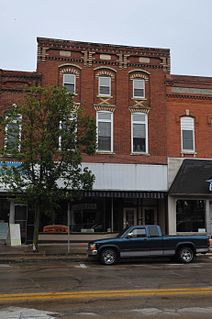
The IOOF Building is a historic building located in Maquoketa, Iowa, United States. Built in 1886, it is a three-story, Late Victorian, brick structure. It is one of several buildings in the central business district that utilizes brick as the primary decorative material. What makes this one unusual is the decorative use of light cream colored brick around the windows, between the second and third floors, and in the cornice. The basement of the building has been used for a barber shop, the main level has housed various retail businesses, and the upper floors are used by the Independent Order of Odd Fellows for their clubhouse. The building was listed on the National Register of Historic Places in 1991.

The Decker House Hotel is a historic building located in Maquoketa, Iowa, United States. James Decker, an entrepreneur from Watertown, New York held numerous real estate holdings in and around Maquoketa. He built the first Decker House, a frame structure, in 1856. After Maquoketa was named the county seat in 1873, Decker decided to replace it. The three-story, brick, Italianate building was designed by Watertown architect W.W. Tucker. Its decoration is limited to the north and east elevations. Noteworthy, is its metal cornice and window hoods. It opened in May 1878, and it had two other competitors in town at that time. Following his death in 1881, James Decker's son Leonard took over his holdings in New York and Iowa. He moved into the Decker House in 1885 and died there in 1900. The building has subsequently lost its entrance porch, original front doors and the pediment over the cornice. It was listed on the National Register of Historic Places in 1978.

The Hotel Hurst Garage, also known as the Roberts Garage, was a historic building located in Maquoketa, Iowa, United States. It was built in 1910 by the owner of the Hotel Hurst next door. The owner of the Decker House Hotel had built a similar building two years earlier. The Hurst sold Buicks and the Decker sold Cadillacs. The cars could serve the needs of the hotels' guests, and it provided an automobile rental service as well as automobile sales. It was a single-story brick structure that featured a tri-partite design. The central garage door was flanked by two display windows that showed off the new cars. The decorative elements were reserved to the top of the building, and included a broad brick paneled frieze, brick corbelled cornice, and a metal cornice. The building was listed on the National Register of Historic Places in 1989. It has subsequently been torn down.

The D.H. Anderson Building, also known as the Sue's Hallmark Store, was a historic building located in Maquoketa, Iowa, United States. The three-story brick building was built in 1882 by Dr. Galloway Truax, a local druggist. The grocery firm of D. H. Anderson initially occupied the first-floor commercial space, and Anderson bought the building in 1888. It remained in the family until 1956. A lawyer and the Knights of Pythias occupied the second floor, and the Masons occupied the third floor. The building had an unusual gable roof to accommodate the Masons' desire for a vaulted ceiling. After the Masons moved out in 1902, the Knights of Pythias occupied the third floor until 1957. Various retail establishments occupied the first-floor retail space. The building was damaged in a 1971 fire. It was listed on the National Register of Historic Places in 1986.

The Cundill Block is a historic building located in Maquoketa, Iowa, United States. Local photographer Will Cundill had this two-story brick commercial building constructed in 1882. His studio was originally located on the second floor before he moved it to the main floor in 1895 when he built an addition onto the back. A variety of retail businesses have occupied the commercial space over the years. The building is representative of the brick commercial buildings that were built in Maquoketa in the 1880s and the 1890s. It features simple brick hoodmolds over the windows and a brick patterned cornice across the top. Although covered, the iron storefront remains in place. The building was listed on the National Register of Historic Places in 1991.
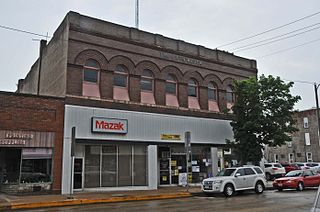
The Lyon Block is a historic building located in Maquoketa, Iowa, United States. Built in 1900, the significance in this building is found in its use of brick. It introduced the use of warm brown into the downtown color scheme. Brick is also the main design element of the building as found in the rhythmical arches above the second floor windows. The color and texture of the wall surface are now the important decorative features and not that which was applied to it. The man floor storefront has been altered, but the significant historical elements of the building have been left in place. The building was listed on the National Register of Historic Places in 1991.

The Merrero Building is a historic building located in Maquoketa, Iowa, United States. It was built in 1918 to replace a three-story brick building on the same location that was damaged in a fire the previous year. While there was a debate about whether to rebuild or build new, it appears they built a new building. It is a two-story structure with three storefronts on the main level. It is significant as an example of early 20th-century commercial design and material. The exterior is composed of white glazed brick with paired windows on the second floor. An old fashioned Italianate metal cornice caps the main facade. While it looks out of place, historic photos show that it is part of the original design. Marble panels were originally located below the display windows on the main floor. The storefront on the left has been altered, but the other two are originals. Transoms above the second floor windows, and the prism glass transoms above the storefronts remain in place, but have been covered. The building was listed on the National Register of Historic Places in 1991.

Mitchell-Maskrey Mill is a historic building located in Maquoketa, Iowa, United States. John Goodenow started the first milling operation in the Maquoketa area in 1838. He sold it to Joseph McCloy who established a larger operation along Mill Creek south of town in 1842. Edward Maskry leased this operation in 1865. He purchased this lot from the Methodist Church a few years later, and operated a mill in the old sanctuary. This three story brick structure was built in 1886 around the old frame church. When it was completed the old church building was dismantled. While it has changed owners, the facility has continuously served the same company. Frank Mitchell partnered with Stephen Maskrey in 1912, and the company has been known as Mitchell-Maskrey Co. ever since. This is the only industrial building in Maquoketa's central business district. The building was listed on the National Register of Historic Places in 1991. The mill sustained some damage in a massive fire on January 19, 2008 that destroyed five buildings and severely damaged a sixth immediately to the west.
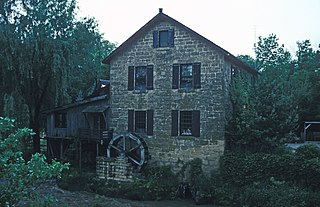
Seneca Williams Mill is a historic building located just outside of Maquoketa, Iowa, United States. Originally known as Oakland Mill, it was built by Joseph Willey in 1867. The 2½-story stone building has a partial basement and is capped with a gable roof. A water-powered turbine, still extant, supplied the power to operate the mill. The location of the mill race can still be seen on the east side of the property, and permanents of the damn remain in Prairie Creek. None of the mill workings remain on the inside. Willey sold the mill to Seneca Williams in 1867, and he operated in until 1904. The building was converted into a barn in 1920. The building was listed on the National Register of Historic Places in 1976. Wildlife artist Patrick J. Costello used the old mill as a residence and studio from 1979 to 2006. His daughter Tracy Costello Taylor has operated it since as a reception hall.
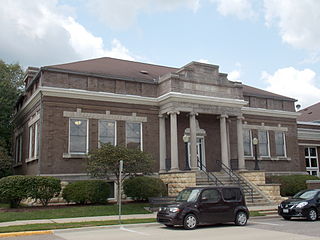
The Maquoketa Public Library is located in Maquoketa, Iowa, United States. The Maquoketa Literary Society was organized as early as 1851, and the Boardman Library Institute was founded in 1885. The community applied to the Carnegie Corporation of New York for a grant to build a free public library, and on March 14, 1902 they were awarded $12,500. The total cost of acquiring the property and constructing the building was $15,000, which they raised by public contributions and entertainments. Independence, Iowa architect Harry Netcott designed the Neoclassical building. It is a single-story brick structure that rests on a raised limestone basement. Bedford stone was used for the trim. It features a symmetrical facade, with columns in the Ionic order that frame the portico. The interior features a columned rotunda. It was dedicated on January 19, 1904. The Boardman Library Institute merged with the Free Public Library after the new building was completed. The roofline was altered slightly when a new roof was added around the middle of the 20th century.

Hurstville Historic District is a nationally recognized historic district located north of Maquoketa, Iowa, United States. It was listed on the National Register of Historic Places in 1979. At the time of its nomination it included three areas: the former lime manufacturing works, a farmstead, and the townsite. All that remains are the four kilns, and an old warehouse. Both the townsite, which was across the road and to the southwest, and the farmstead, which was behind the kilns to the south, are gone. Also gone are the remaining company buildings, with the exception of the old warehouse, which were across the road to the west. The houses in the townsite were side-gable cottages. Many lacked indoor plumbing into the 1970s and were vacant. The farmstead included 20 structures devoted to domestic or agricultural use. Two large barns were the most notable structures. The farm served the needs of the town. The most significant structures in the district were the lime kilns.

The D.H. Anderson House is a historic house located at 315 East Locust in Maquoketa, Iowa.

The A.A. Hurst House is a historic residence located in Maquoketa, Iowa, United States. This house shows the strongest influences of the Prairie School style in town. It was built on the site of a previous house at a time when newer and larger houses were replacing Maquoketa's older buildings. It was designed by Davenport architect E.G. Holbrook. The two-story house features a low pitched hip roof, broad eaves, paired windows, banded windows in groups, a stuccoed exterior, and a broad porch. Abe A. Hurst was the son of Alfred Hurst, who founded the A. Hurst and Company Lime Works and the company town of Hurstville. In addition to the family business, they were also involved with Maquoketa Electric Light and Power Company. This connection allowed Abe to be involved with the construction of Lakehurst, a hydro dam and power plant, in 1923. The house was listed on the National Register of Historic Places in 1991.

The John Lake House is a historic residence located in Maquoketa, Iowa, United States. This is one of several Victorian houses in Maquoketa that are noteworthy for their quoined corners, a rare architectural feature in Iowa. Built around 1890, the 1½-story house features limestone quoins, a gable roof, gambrel dormers on the north and east elevations, a polygonal bay under the east dormer, two small porches, and a gabled wing on the west side. A unique feature on this house are the glazed colored tiles on the main facade. John Lake was a local builder, who is associated with the construction of the New Era Building and the IOOF Building. It is possible he built this house as well, although the builder has not been determined. The house was listed on the National Register of Historic Places in 1991.

The J.E. Squiers House, also known as the Squiers Manor Bed and Breakfast, is a historic building located in Maquoketa, Iowa, United States. The architectural and historic significance of this house is attributed to its being "a well-preserved example of late nineteenth century domestic architecture in Maquoketa's most prominent residential neighborhood and for its association with the life and career of James Emery Squiers, a prominent local businessman." Built in 1882, the 2½-story brick house features elements consistent with the Queen Anne and Stick styles. It follows a central hall floor plan with two rectangular projecting bays, a three-sided bay window, a kitchen addition on the back, and a hipped roof with intersecting gable sections.

111 East Maple Street is a historic house located at the address of the same name in Maquoketa, Iowa.

The West Pleasant Street Historic District is a nationally recognized historic district located in Maquoketa, Iowa, United States. It was listed on the National Register of Historic Places in 1991. At the time of its nomination it contained 50 resources, which included 29 contributing buildings, 21 non-contributing buildings, and one non-contributing site. The historic district is primarily a residential area that was built during Maquoketa's "Boom Years" (1873-1899) and the "Comfortable Years" (1900-1922). The first house built in the district was in 1863 and the last was in 1914. This is where many of the city's business and professional leaders choose to build their houses. Most of the 28 houses were probably not designed by an architect, but were crafted in the "High Style" of the time by local builders. With the exception of Greek Revival, all the major styles of the period built in Maquoketa are found here. Eight of the houses and one of the three remaining carriage houses are brick structures; the rest are wood.

The former Jackson County Jail, also known as the Andrew Jail, is a historic building located in Andrew, Iowa, United States. Built in 1871 by local contractors Strasser and Schlecht, this building is the only reminder that Andrew was at one time the county seat for Jackson County. The stone blocks were quarried locally and vary somewhat in shape and size. They were laid in courses, and the window sills and lintels are composed of flat stones. The structure is capped with a cross-gable roof. After the courthouse moved to Maquoketa in 1873 the jail remained here until 1896. After a new jail was built in Maquoketa, this building was primarily used as a residence. A couple of frame additions have been built onto the building. It was listed on the National Register of Historic Places in 1978.
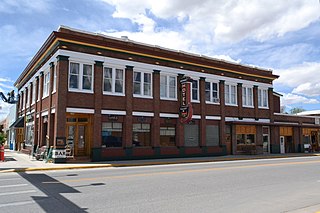
The Carey Block—located at 602 Greybull Ave. in Greybull, Wyoming—is a building that was built in 1916. It has also been known as Hurst Block, First State Bank, and Greybull Hotel .






















